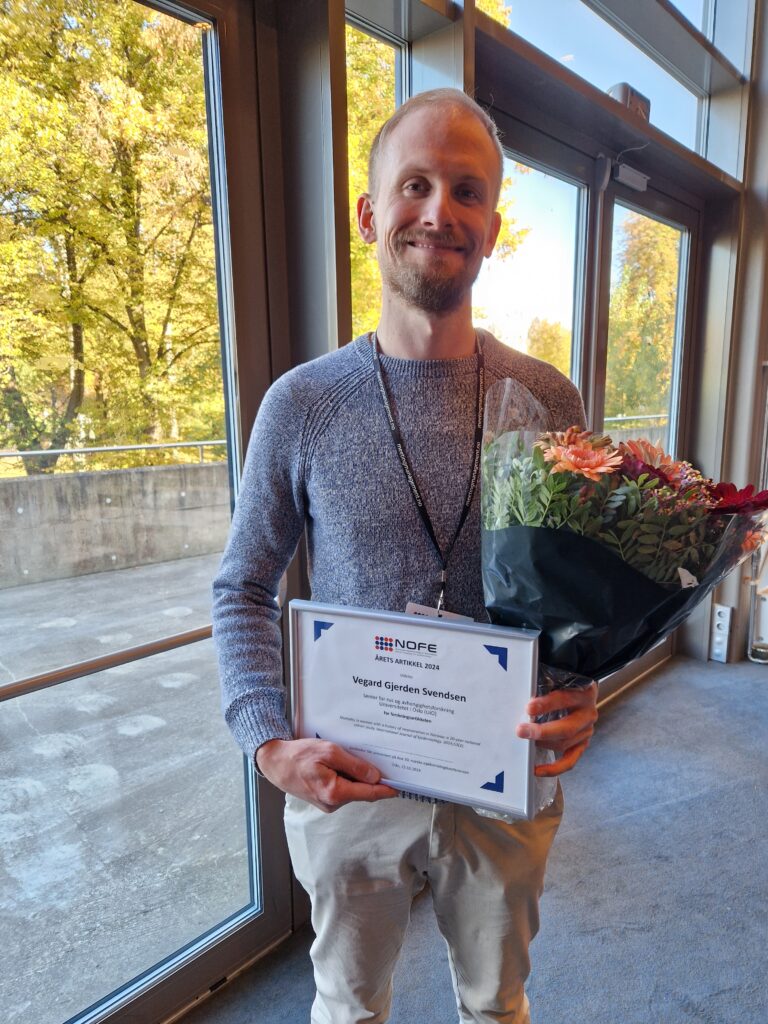NOFE’s “Paper of the year” prize
The NOFE prize for Paper of the year (NOK 10 000,-) will be awarded to a first author of an epidemiologic paper which has been published with a DOI number (online or in print) in an international scientific journal from September of the previous year up to and including August this year. The paper must be based on data from Norway and affiliated with a Norwegian institution. The award will be presented at the annual NOFE conference in October/November. The deadline for submitting candidate proposals is 1st September and should be sent to post@nofe.no. The submitter is encouraged to provide a brief justification for the nomination.
The nominated papers will be evaluated by a committee appointed by the NOFE board. Assessment criteria are: Outstanding scientific quality and integrity in a) methodologic robustness, b) presentation, and c) contribution to the field. The first author of the paper must be able to attend the conference to receive the award and present the paper. If the first author is not able to attend, it must be agreed in advance that a co-author may attend the conference to receive the award and present the paper on behalf of the first author.
____________________________________________________________________________

Congratulations to Vegard Svendsen for NOFEs prize for Paper of the year 2024!
The award was presented at the 30th NOFE conference in Oslo October 2024.
The winner of the paper of the year 2024 is Vegard Svendsen and co-authors with the article “Mortality in women with a history of incarceration in Norway: a 20-year national cohort study” published in the International Journal of Epidemiology in February this year.
The winning paper is well-written, delivering a clear and impactful public health message. It addresses a novel research question focused on a marginalized and under-researched population. The study exemplifies the importance of well-executed descriptive epidemiology, shedding light on a significant issue with clear potential for prevention.
Previous winners:
2023: Simon Lergenmuller and Corina S. Rueegg
Lergenmuller, Simon, et al. Lifetime sunburn trajectories and associated risks of cutaneous melanoma and squamous cell carcinoma among a cohort of Norwegian women. JAMA Dermatology (2022)
2022: Øystein Karlstad
Karlstad, Øystein, et al. SARS-CoV-2 Vaccination and Myocarditis in a Nordic Cohort Study of 23 Million Residents. JAMA cardiology 7.6 (2022).
2021: Maria Brandkvist
Brandkvist, Maria, et al. Genetic associations with temporal shifts in obesity and severe obesity during the obesity epidemic in Norway: A longitudinal population-based cohort (the HUNT Study). PLoS medicine 17.12 (2020).
2020: Ben Brumpton
Brumpton, B, et al. Avoiding dynastic, assortative mating, and population stratification biases in Mendelian randomization through within-family analyses. Nat Commun 11, 3519 (2020).
2019: Ekaterina Sharashova
Sharashova E, et al. Long-term blood pressure trajectories and incident atrial fibrillation in women and men: the Tromsø Study. Eur Heart J 2020; 41:1554-1562
2018: Mats Julius Stensrud
Stensrud MJ, Valberg M. Inequality in genetic cancer risk suggests bad genes rather than bad luck. Nat Commun 2017; 8: 1165
2017: Paz Lopez-Doriga Ruiz
Paz LD Ruiz, et al. Pandemic Influenza A H1N1 Vaccination and Subsequent Risk of Type 1 Diabetes in Norway. Epidemiology 2018; 29: e6-e8
2016: Maria Magnus
Maria C. Magnus, et al. Infant Growth and Risk of Childhood-Onset Type 1 Diabetes in Children From 2 Scandinavian Birth Cohorts. JAMA Pediatr. 2015;169(12):e153759
2015: Mette C Tollånes
Tollånes MC, et al. Familial risk of cerebral palsy: population based cohort study. BMJ 2014; 349: g4294
2014: Morten Valberg
Valberg M, et al. A Hierarchical Frailty Model for Familial Testicular Germ-Cell Tumors. Am J Epidemiol. 2014; 179: 499-506
2013: Siri E Håberg
Håberg SE, et al. Risk of Fetal Death after Pandemic Influenza Virus Infection or Vaccination. NEJM 2013; 368: 333-340
2012: Christine Roth
Roth C, et al. Folic Acid Supplements in Pregnancy and Severe Language Delay in Children. JAMA 2011; 306: 1566-1573
2011: Astri Syse
Syse A, et al. Is mortality after childhood cancer dependent on social or economic resources of parents? A population based study.
2010: Martha Ebbing
Ebbing M, et al. Cancer incidence and mortality after treatment with folic acid and vitamin B12.
2009: Christine L Parr
Parr CL, et al. Recall Bias in Melanoma Risk Factors and Measurement Error Effects: A Nested Case-Control Study Within the Norwegian Women and Cancer Study.
2008: Harald Weedon-Fekjær
Weedon-Fekjaer H, et al. Breast cancer tumor growth estimated through mammography screening data.
2007: Petter Kristensen
Kristensen P, Bjerkedal T. Explaining the relation between birth order and intelligence.
2006: Kåre Bønaa
Bønaa KH, et al. Homocysteine lowering and cardiovascular events after acute myocardial infarction.
2005: Stein Harald Johnsen
Johnsen SH, et al. Monocyte count is a predictor of novel plaque formation. A 7-Year follow-up study of 2610 persons without carotid plaque at baseline. The Tromsø Study.
2004: Hans Steinsland
Steinsland H, et al. Protection from natural infections with enterotoxigenic Escherichia coli: longitudinal study.

